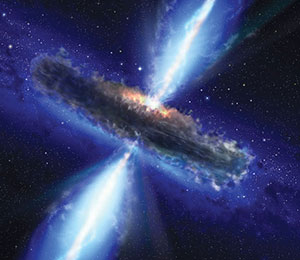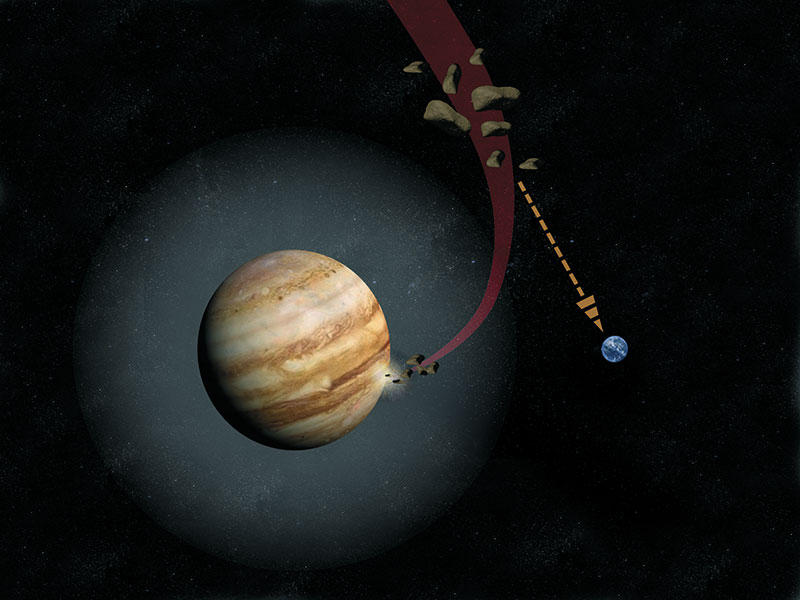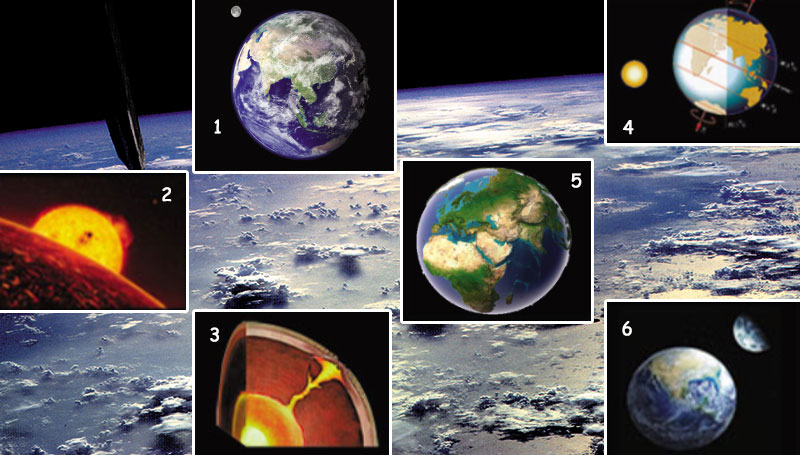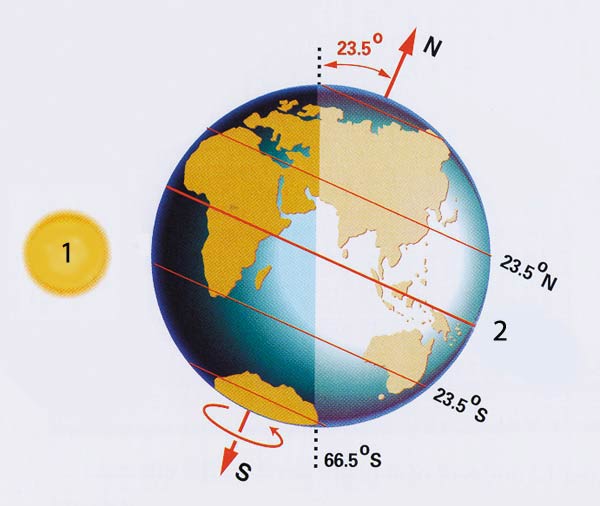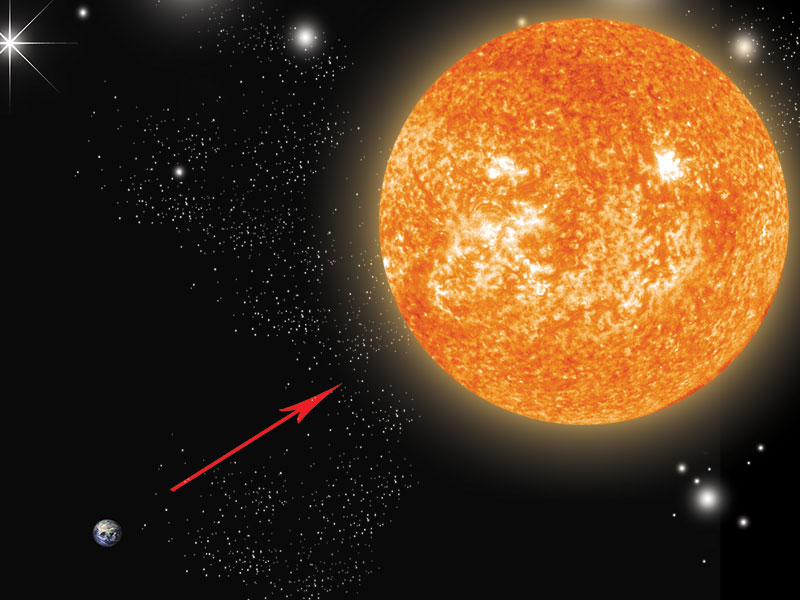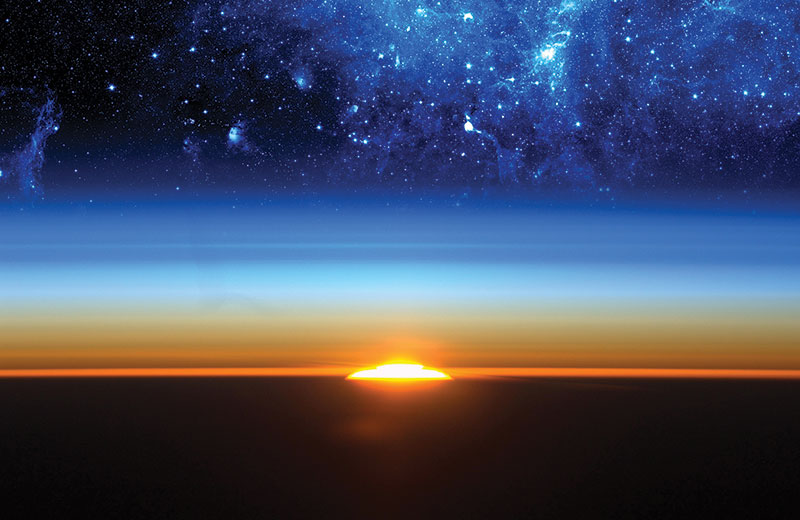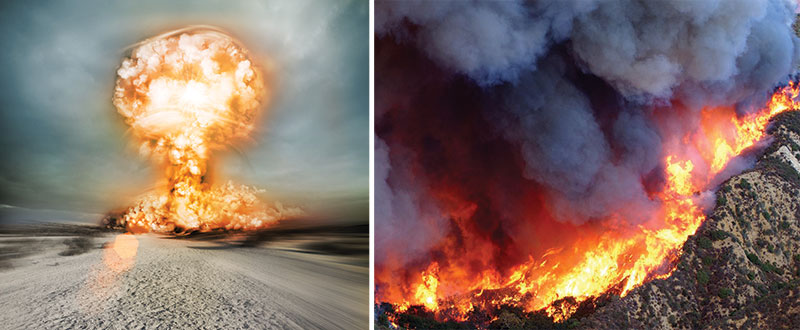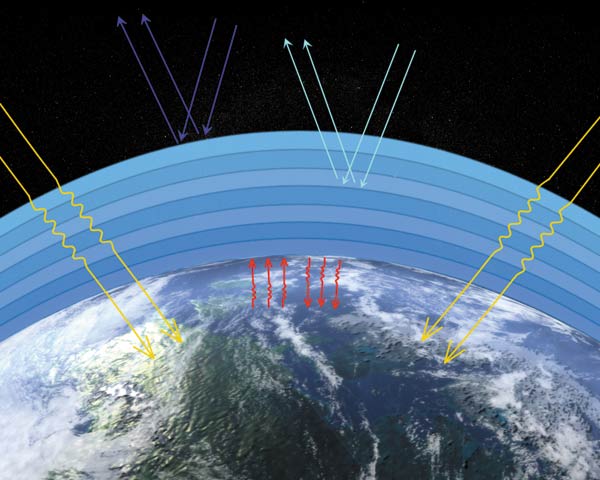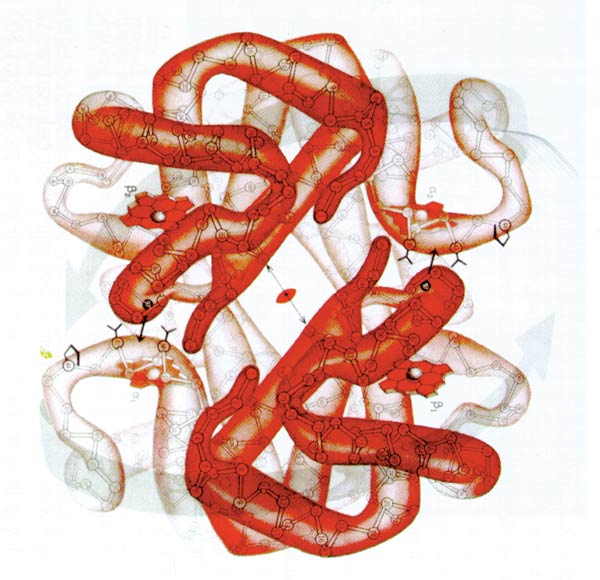Bigotry: The Dark Danger
A Chain of Miracles

DOWNLOAD THE BOOK
CHAPTERS OF THE BOOK
< <
3 / total: 5
Chapter 2: The Solar System and The Miraculous Order in The Creation of The EarthThe Location of the Solar System in the Galaxy
The location of our solar system in the Milky Way is the product of awe-inspiring order and flawless design. Its trajectory is far from the center of the galaxy, and outside its spiraling arms. Stars and planets in a spiral galaxy like the Milky Way are structured around the bloated core. The spiraling arms move away from the center of the galaxy at a consistent angle and plane. The spaces between these arms contain only a negligent number of solar systems—and our own solar system is one of these rare examples. Is it somehow relevant that our solar system is located between the spiral arms of the galaxy? First, it means that we are far removed from the gases and other debris contained in the spiraling arms, giving us a clean, clear view of the universe from where we are. Had our solar system been located inside these spiral arms, our view would have been considerably obscured. As Michael Denton writes in his book Nature’s Destiny: What is so striking is that the cosmos appears to be not just supremely fit for our own being and for our biological adaptations, but also for our understanding... Because of the position of our solar system on the edge of the galactic rim, we can gaze farther into the night to distant galaxies and gain knowledge of the overall structure of the cosmos. Were we positioned in the center of a galaxy, we would never look on the beauty of a spiral galaxy nor would we have any idea of the structure of our universe. 25 Normally, stars located between spiral arms cannot maintain their position for prolonged periods of time, since they are eventually absorbed into the spirals. Yet our solar system has maintained its orbit between the galaxy’s spiral arms for the past 4.5 billion years. Our location's stability is due to the fact that our Sun is one of very few stars positioned on the trajectory called "galactic co-rotation radius."
For a star to maintain its position between two spiral arms depends on its distance from the core of the galaxy. In other words, it needs to be on the co-rotation radius, so that it travels around the center at the same speed as do the spiral arms.26 Among our galaxy’s billions of stars, only our Sun has both this special position as well as the required velocity. Our position, outside of the spiral arms where stars cluster, is also the safest place in the universe, since here we are removed from gravitational forces that could destabilize the orbits of planets. Also, we are out of reach of the deadly effects of supernova explosions. In any other part of the galaxy, our Earth could not have survived the 4.5 billion years it took to make it a place suitable for human life. Thanks to the creation of our solar system in this special position, life—and human life—can be sustained on Earth. This is the reason why we can investigate the universe we live in and observe the unequalled, supreme, spectacular artistry in God’s creation. The location of our solar system, just like the laws of physics governing the universe, is proof that it was designed for human existence.
The Precise Order In Our Solar SystemThe solar system that is home to our Earth is one of the best places to observe the universe’s precise order and harmony. The unequalled order that controls all planets, large or small, within the solar system has been responsible for its stability over the past 4.5 billion years. In our solar system, there are nine planets, and orbiting them are the 54 satellites discovered so far. Beginning with the nearest to the Sun, these planets are: Mercury, Venus, Earth, Mars, Jupiter, Saturn, Neptune, Uranus and Pluto. Out of all these planets and their satellites, Earth is the only one with a surface and atmosphere suitable for life. The balance between the Sun’s gravity and any planet’s centrifugal force prevents it from being flung out into space. The Sun’s massive gravitational force attracts the planets, which can only withstand this force and not fall into the Sun’s nuclear furnace because of the centrifugal forces their motion creates. If the planets’ speed were a little slower in their orbits, however, they would be rapidly pulled into towards the Sun, which would swallow them up. The opposite is also possible. Were the planets to rotate any faster, the Sun’s gravitational forces would not be powerful enough to keep them in their orbits and they would be cast out into space. However, a fine balance between these forces exists, and the solar system preserves it. This balance of forces differs separately for each planet in any solar system, since their respective distances to the Sun vary. Their masses are different too, which means that they must revolve around the Sun at different velocities in order to maintain their equilibrium. The same balanced forces exist for the Earth.
The latest discoveries in astronomy reveal that the existence of other planets in our solar system is vital for the Earth’s safety and orbit. The system’s largest planet, Jupiter, is a good example. With its exact location within the system, it plays a crucial role in maintaining the Earth’s balance. Recent astrophysical calculations reveal that Jupiter’s present orbit is partly responsible for the consistency of the other planets’ orbits within the solar system. Huge planets like Jupiter have been discovered in many other solar systems, but they are far from having a stabilizing influence on their systems or from protecting any other, smaller planets therein. Peter D. Ward, a Professor of Geological Sciences at the University of Washington, says: All the Jupiters seen today are bad Jupiters. Ours is the only good one we know of. And it’s got to be good, or you’re thrown out into dark space or into your sun. 27 Another reason why Jupiter is so important for us is that if it did it not exist, there would be no life on Earth, due to the high number of meteorite impacts our planet would be exposed to. The magnetic field created by Jupiter’s huge mass bends the trajectory of comets and meteorites entering the solar system and prevents them from targeting the Earth. Jupiter acts as a protective gravitational shield for the Earth. Yet another way Jupiter protects the Earth is revealed by astronomer George Wetherhill in his article entitled “How Special Jupiter Is”:
Without a large planet positioned precisely where Jupiter is, the earth would have been struck a thousand times more frequently in the past by comets and meteors and other interplanetary debris. If it were not for Jupiter, we wouldn't be around to study the origin of the solar system. 28 It has been calculated that the Earth-Moon planetary system also plays a vital role in preserving balance in the solar system. In the absence of this duo, Jupiter’s huge mass would cause great instability to inner planets like Mercury and Venus; with the result that their orbits would approach one another closer and closer. This in turn would force Mercury out of the solar system and alter the orbit of Venus. Scientists developed a computer model of the solar system, clearly revealing that the order and consistency preserved for billions of years was only possible only by the ideal mass and positioning of planets within the solar system. With the slightest change to the existing order within this system, our solar system, including the Earth, could not exist. The Astronomical Journal described the extraordinary design inherent in our solar system in its November, 1998 issue: Our basic finding is nevertheless an indication of the need for some sort of rudimentary "design" in the solar system to ensure long-term stability…29 In short, our solar system’s structure has been designed specifically for human life. God reveals His miraculous Creation in many verses of the Qur’an and commands us to ponder them: He has made night and day subservient to you, and the Sun and Moon and stars, all subject to His command. There are certainly Signs in that for people who use their intellect. (Qur’an, 16:12)
The Size of The Earth and The Ideal Proportions in Its InteriorEqually as important as the Earth’s distance from the Sun, and rate of rotation is its size and composition, just right for forming and sustaining life. When we compare the Earth to Mercury (only 8% of the Earth’s mass) and Jupiter (318 times the Earth’s mass), we see that planets span a wide range in terms of size. Considering this it is obvious that the Earth couldn’t be of just the right mass by coincidence.
Investigating the properties of the planet we live on, American geologists Frank Press and Raymond Siever write the following: And Earth's size was just about right—not too small as to lose its atmosphere because its gravity was too small to prevent gasses from escaping into space, and not so large that its gravity would hold on to too much atmosphere, including harmful gases. 31 Besides the mass of the Earth, its internal composition is also designed specifically to support life. Because of its inner core of iron, Earth has a magnetic field, which is crucial for the preservation of life. Press and Siever explain: The earth's interior is a gigantic but delicately balanced heat engine fueled by radioactivity …Were it running more slowly, geological activity would have proceeded at a slower pace. Iron might not have melted and sunk to form the liquid core, and the magnetic field would never have developed…if there had been more radioactive fuel and a faster running engine, volcanic gas and dust would have blotted out the Sun, the atmosphere would have been oppressively dense, and the surface would have been racked by daily earthquakes and volcanic explosions. 32
The magnetic field that Press and Siever describe is vital for our survival. It is caused by the core of the Earth which is composed of heavy, magnetic metals like iron and nickel. The inner core is solid and the outer core, liquid. These two layers rotate around one another, and their motion creates the magnetic field, which radiates far beyond the Earth's atmosphere and protects the planet from the dangers of outer space. Deadly cosmic radiation emitted from stars including our own Sun cannot penetrate this protective shield. The Van Allan belts, tens of thousands of kilometers above the Earth, provide more protection from such deadly radiation. The Earth is sometimes exposed to massive bursts of cosmic radiation. These plasma clouds have been calculated to have energy equivalent to 100 billion Hiroshima bombs, but only 0.1% of it gets past the Earth's magnetic field and that is absorbed by the Earth's atmosphere in any case. The electrical energy needed to produce this magnetic field is a current of 1 billion amperes, which is close to the total electrical energy produced by mankind since history began. If not for the Earth's magnetic shield, life on Earth would be destroyed by deadly radiation or would never have formed in the first place. However, since the core of the Earth has just the right properties, as Press and Siever point out, the world we live in, is protected in this way.
The Earth' S Temperature Is Within A Narrow But Special SpectrumFrank Press and Raymond Siever also explain the fine-tuning of the Earth’s surface temperature. As they say: Life as we know it is possible over a very narrow temperature interval. This interval is perhaps 1 or 2 percent of the range between a temperature of absolute zero and the surface temperature of the Sun.33 Preserving this temperature range depends as much on the heat emitted by the Sun as on the distance between the Sun and the Earth. It has been calculated that only a 10% decrease in the solar energy reaching the Earth would result in the Earth's surface being covered by a layer of ice covering, many meters thick. Likewise, if a little more energy reached the Earth, all living beings would roast. The Earth's ideal temperature is as crucial as its balanced diffusion; and this balance is achieved by special means. For instance, the Earth's axis is tilted by 23" 27'. This prevents the buildup of extreme heat that could prevent the formation of the atmosphere between the poles and the equator. If the axis was not tilted by this degree, the temperature difference between the equator and the poles would increase dramatically thus making the Earth an uninhabitable place. The Earth's rotation around its own axis aids in the balanced distribution of heat. Each rotation takes only 24 hours, which factor is responsible for short days and nights. This is why the temperature difference between day and night is relatively small in comparison to Mercury's, where a single day is longer than one year. In other words, one rotation of Mercury around its axis takes longer than one rotation around the Sun. Temperature can fluctuate by as much as 1,0000 C (1,832 0 F) between Mercurial day and night. The Earth’s shape, too, has been created to aid the heat distribution. The temperature difference between the poles and the equator is approximately 1000C (2120 F). If such a difference were to occur on a smooth sphere, storms at speeds of up to 1,000 km/h (621 miles/hour) would wreak havoc across the Earth. However, the world has been provided with obstacles such as mountain chains and oceans to break up the path of such potential strong air currents. These are, from east to west, the Himalayas beginning in China, the Taurus Mountains in Anatolia, and the Alps in Western Europe; the Atlantic Ocean in the West, and the Pacific in the East. Excess heat produced around the equator is modified toward the north and south as the ocean waters balance temperature fluctuations in a gradual, controlled manner.
There are also self-regulating climate control mechanisms. For instance, if any particular area is exposed to excessive heat, water evaporation increases accordingly. Clouds condense in the sky, reflecting some of the Sun’s radiation and thus preventing any further increase of surface temperatures. Those who reject the notion that the distance between the Sun and the Earth is intentional argue that many stars in the universe, both larger and smaller than our own Sun, have their own planetary systems. If a star is much more massive than our Sun, than any planet ideal for life would need to be at a greater distance than is the Sun from the Earth. For instance, a planet orbiting a red giant at a distance of our Pluto could have a mild climate suitable for life, like the one we enjoy here on Earth.
But this proposition is invalid for one very important reason: It does not take into account that stars of different mass emit different radiation. A star’s mass, correlated to its surface temperature, determines the wavelength of its emitted radiation. For instance, our Sun’s surface temperature of around 60000C is responsible for the emission of ultraviolet, visible light and infrared radiation. Had its mass had been greater, its surface temperature should have been greater too. This, in turn, would increase the energy value of the Sun’s radiation resulting in higher emission of deadly ultraviolet waves. This reality demonstrates that stars emitting the kind of radiation able to support life as we know it must have a mass very similar to our Sun’s. Also, if one of their planets is to support life, it must be at a distance equivalent as the Earth from our Sun. To put it differently, a planet orbiting a red or blue giant, or any other star of noticeably different mass, cannot provide a life-supporting environment. The only source of energy suitable for life is a star like ours, and the only ideal distance is that between us and the Sun. From what we have related here thus far, you can gather that both Earth and Sun have been created by God, right down to the smallest detail, to support human life in the best possible way. The distance between Sun and Earth is perfect, which in itself is a miracle beside the hundreds, even thousands of other details that are exactly as they need to be. This magnificent life-supporting system exceeds human comprehension. It is impossible to have been the product of coincidences, that all the stars and planets formed by “senseless atoms” could be placed by chance exactly where they have to be, that they could accidentally, all by themselves, establish laws governing their behavior and, accordingly develop the appropriate systems. These flawless systems are all proof of God’s unique creation and supreme might. The Qur’an reveals God’s supremacy, his total control over the universe and the Earth, and that mankind should be thankful to him for all this: Your Lord is God, Who created the heavens and the Earth in six days and then settled Himself firmly on the Throne. He covers the day with the night, each pursuing the other urgently; and the Sun and Moon and stars are subservient to His command. Both creation and command belong to Him. Blessed be God, the Lord of all the worlds. (Qur’an, 7:54) And He has made the Sun and Moon subservient to you holding steady to their courses, and He has made the night and day subservient to you. He has given you everything you have asked Him for. If you tried to number God’s blessings, you could never count them. Man is indeed wrongdoing, ungrateful. (Qur’an, 14:33-34)
Ideal Ratios In The AtmosphereThe Earth’s atmosphere is a cocktail of different gases in the proper ratio (78% nitrogen, 21% oxygen, 1% carbon dioxide and other gases like argon), formed by a combination of extraordinary conditions and designed to support life. Let us begin with oxygen, the most important gas because life forms from simple one-called bacteria up to complex human beings depend on oxygen for the many chemical reactions that produce their energy. This is why we need to breathe continuously. Interestingly, the percentage of oxygen in the air we breathe is very carefully arranged. As Michael Denton says: Could your atmosphere contain more oxygen and still support life? No! Oxygen is a very reactive element. Even the current percentage of oxygen in the atmosphere, 21 percent, is close to the upper limit of safety for life at ambient temperatures. The probability of a forest fire being ignited increases by as much as 70 percent for every 1 percent increase in the percentage of oxygen in the atmosphere. 34 British biochemist James Lovelock further explores this critical ratio: Above 25% very little of our present land vegetation could survive the raging conflagrations which would destroy tropical rain forests and arctic tundra alike... The present oxygen level is at a point where risk and benefit nicely balance. 35 The percentage of oxygen in the atmosphere is preserved by a perfect cycle. Animals continuously inhale oxygen and exhale carbon dioxide. Plants, on the other hand, absorb carbon dioxide and give out life-sustaining oxygen. Every day, plants release billions of tons of oxygen into the atmosphere, even though they re-absorb some of it at night, when they are not photosynthesizing.
If these two life forms, plant and animal, were to use the same process, they’d turn the Earth into a lifeless planet. If both produced oxygen, for instance, in a very short time the atmosphere would acquire highly flammable properties, and the tiniest spark would cause fires on a massive scale. Most of the dry land would burn. If, on the other hand, both life forms produced carbon dioxide, oxygen in the atmosphere would quickly be used up and all life forms that continued to respire would suffocate. However, God has balanced life forms so perfectly that the oxygen in the air remains constant, at the ideal ratio crucial to life. According to Lovelock, this ratio is “at a point where risk and benefit nicely balance.”
The mix of atmospheric gases is balanced, with each occurring at its ideal quantity. Even carbon dioxide, useless to us, is a very important substance because it prevents some of the infrared sunlight reflected by the Earth from escaping back into space, and thus assists heat retention. Biological and tectonic processes on the Earth preserve the balance of atmospheric gases vital for life, and have done so for millions of years. Yet another fact that proves the existence of God, Who has created this flawless order. Carbon dioxide in the atmosphere has been calculated to increase the average surface temperature by 35 °C (95° F). This means that if there was no atmospheric CO2, the Earth’s average temperature would be -21 °C (-5.8 ° F) instead of 14° C (57.2° F). All oceans would freeze over. Most larger life forms would cease to exist. The Density of AirThe density of air, ideal for respiration, is yet another exactly perfect aspect of the atmosphere. Air pressure is 760 mmHg, and its density works out to be 1 gram per liter at sea level, where its viscosity is 50 times greater than water’s. These values might appear irrelevant, but are actually vital for human life because, as Michael Denton puts it, “The overall composition and general character of the atmosphere—its density, viscosity, and pressure, etc.—must be very similar to what it is, particularly for air-breathing organisms.” 36 When we breathe, our lungs use up energy in order to pump the air in and out. Like all forms of matter, air is resistant to movement. But thanks to the properties of the gaseous atmosphere, this resistance is very weak, making it easy for our lungs to inhale and exhale. If that resistance were stronger, our lungs would begin to struggle. You can easily grasp this with an experiment: It’s easy to draw water into a syringe, but harder to draw honey, because honey has a higher density and lesser fluidity. If the atmosphere’s values of density, fluidity, and pressure were altered by even a fraction, inhaling would become as hard as drawing honey into a syringe. One could argue that the syringe’s needle could be made wider, in other words, the lung’s airways could be enlarged. But if we did that in the case of the capillaries in the lungs, the result would be to reduce the size of the area in contact with air, with the result that less oxygen and carbon dioxide would be exchanged in the same amount of time and the respiratory needs of the body would not be satisfied. The air we breathe in has the absolutely right density, fluidity and pressure and fits the bill just fine.
On this subject, Professor Michael Denton states the following: It is clear that if either the viscosity or the density of air were much greater, the airway resistance would be prohibitive and no conceivable redesign of the respiratory system would be capable of delivering sufficient oxygen to a metabolically active air-breathing organism... By plotting all possible atmospheric pressures against all possible oxygen contents, it becomes clear that there is only one unique tiny area... where all the various conditions for life are satisfied... It is surely of enormous significance that several essential conditions are satisfied in this one tiny region in the space of all possible atmospheres. 37 Our atmosphere’s properties must be right not only for respiration purposes, but also to keep our “blue planet” blue. If the pressure were to be decreased by as little as a fifth, water evaporation over the land and oceans would increase dramatically. Higher water vapor content in the atmosphere would create a global greenhouse effect, dramatically increasing the planet’s average temperature. On the other hand, if the atmospheric pressure doubled, water vapor in the atmosphere would be greatly reduced, with most of the world’s land area becoming desert. None of these possibilities occur, however, because God has created the world, the solar system, and the whole universe flawlessly. He has created the whole of the Earth in order to provide us with suitable living conditions. God reveals this perfect creation in the Qur’an and demands that we reflect on these examples to appreciate his creation:
The Miracle of Visible LightNot all the stars and other sources of light in the universe emit the same type of radiation. Different types of radiation are classified according to their respective wavelengths. They fall along a huge spectrum, with gamma rays being the shortest and radio waves the longest. The difference between these shortest and longest waves is 1025(ten times billion times billion times billion). Miraculously, most of the Sun’s radiation lies in the same bundle of wavelengths within this vast spectrum, because only that narrow band contains the radiation necessary to support life. The vastness of this spectrum becomes clearer when you realize that the shortest wavelength is 1025 times shorter than the longest. 10251025 is written out as a 1 with 25 zeros following it, like this: 10,000,000,000,000,000,000,000,000. To fully comprehend the magnitude of this number, it helps to make some comparisons. For instance, the 4.5 billion years that have passed since the Earth’s creation can be converted to 1017 seconds. If you wanted to count to 1025 , you would have to count day and night for a period 100 million times longer than the age of the Earth. If we were to pile 1025playing cards on top of one another, we would leave the Milky Way behind and cover about half the distance of the known universe! 38
The different wavelengths in the universe are spread across that wide a spectrum, but within it, interestingly, our Sun covers only the narrowest bandwidth. 70% of the Sun’s radiation has wavelengths between 0.3 and 1.5 microns. Within this narrow bandwidth are three different types of light; visible light, infrared, and some ultraviolet. All three types of light combined make up an almost insignificant section of the total spectrum. In other words, they would be represented by one of the 1025 cards. But why does the Sun’s radiation lie within this narrow bandwidth? The answer to that question is extremely important: It’s the only type of radiation that can support life on Earth. Addressing this question in Energy and the Atmosphere, British physicist Ian Campbell says that "the radiation from the sun (and from many sequence stars) should be concentrated into a minuscule band of the electromagnetic spectrum which provides precisely the radiation required to maintain life on earth is very remarkable." According to Campbell, this situation is “staggering.”39 The Extraordinary Relationship Between Sunlight And Photosynthesis
Plants have been doing something for hundreds of millions of years that no high-tech lab, run by scientific specialists, has yet been able to do: They produce their own nutrition by a process called photosynthesis, using sunlight. A precondition of this process, however, is that suitable light reach the plants in the first place. Photosynthesis is made possible by the light-sensitive chlorophyll molecules in the plants’ cells. But chlorophyll however can make use of light at a certain wavelengths only, and the ones emitted by the Sun are just right. (Interestingly, the one required for photosynthesis is one in the 1025 different wavelengths.) That sunlight identical to the light necessary for photosynthesis shows its perfect design. In The Symbiotic Universe, American astronomer George Greenstein writes as follows: Chlorophyll is the molecule that accomplishes photosynthesis... The mechanism of photosynthesis is initiated by the absorption of sunlight by a chlorophyll molecule. But in order for this to occur, the light must be of the right color. Light of the wrong color won't do the trick. A good analogy is that of a television set. In order for the set to receive a given channel it must be tuned to that channel; tune it differently and the reception will not occur. It is the same with photosynthesis, the Sun functioning as the transmitter in the analogy and the chlorophyll molecule as the receiving TV set. If the molecule and the Sun are not tuned to each other-tuned in the sense of color—photosynthesis will not occur. As it turns out, the sun's color is just right. 40Those who examine this subject of plants and photosynthesis superficially could argue that if sunlight had different properties, plants would have adapted accordingly. But this is most certainly impossible. George Greenstein admits that this is, even though he is an evolutionist: One might think that a certain adaptation has been at work here: the adaptation of plant life to the properties of sunlight. After all, if the Sun were a different temperature could not some other molecule, tuned to absorb light of a different color, take the place of chlorophyll? Remarkably enough the answer is no, for within broad limits all molecules absorb light of similar colors. The absorption of light is accomplished by the excitation of electrons in molecules to higher energy states, and the same no matter what molecule you are discussing. Furthermore, light is composed of photons, packets of energy and photons of the wrong energy simply can not be absorbed… As things stand in reality, there is a good fit between the physics of stars and that of molecules. Failing this fit, however, life would have been impossible.41 Essentially, Greenstein says that for a plant to photosynthesize, it requires a definite bandwidth of light, which sunlight perfectly fulfills. Greenstein states that the harmonies between the physical properties of stars and of molecules are so extraordinary that they cannot possibly be explained by coincidences. The fact that the Sun emits light at a certain wavelength from a possible range of 1025 others, and that complex molecules on Earth can absorb this light, most certainly proves that this harmony was created consciously, by God.
The Extraordinary Harmony Between Sunlight And The EyeOnly the “visible light” wavelengths on the electromagnetic spectrum can enable biological vision. The largest part of the radiation emitted by the Sun falls within this parameter.
For vision to occur, the cells of the retina must be photosensitive, in other words, able to register photons. This requires that photons fall within the visible spectrum, because photons of different wavelength are either too weak or too strong to be registered by retina cells. Altering the size of the eye would make no difference, because what matters is the size of the cells, the harmony between them, and the wavelength at which the photons occur. Consequently, eyes of living beings register only the visible light emitted by the Sun. These factors combine to create vision. God specifically created both the eye and the Sun that emits light at the proper wavelength for it to perceive.
Professor Michael Denton investigated this subject in great detail in his book Nature’s Destiny, concluding that an organic eye could produce vision only within the limits of visible light. No other theoretically conceivable eye design can register different wavelength: UV, X-ray, and gamma rays are too energetic and are highly destructive, while infrared and radio waves are too weak to be detected because they impart so little energy interacting with matter... And so it would appear that for several different reasons, the visual region of the electromagnetic spectrum is the one region supremely fit for biological vision and particularly for the high-resolution vertebrate camera eye of a design and dimension very close to that of the human eye.42 Taken all together, this all leads to the conclusion that the Sun is carefully designed to emit radiation at a certain bandwidth (1 in 1025), providing heat, supporting the biological functions of complex life forms, enabling photosynthesis and making possible vision for living beings on Earth. This critical balance is certainly not driven by erratic, coincidental processes. All this has been created by God, the Lord and Governor of the heavens, the Earth, and everything in between. Every detail He creates confronts us with a chain of miracles, demonstrating the infinite might of our Creator Who created everything. The Extraordinary Selectiveness of The Atmosphere
If the Sun's radiation has been designed to support life on Earth, the atmosphere plays an important role in letting through it wavelengths in the right combination and at the right ratio. In order to reach the Earth's surface, radiation coming from space must pass through the atmosphere first. If the atmosphere were not of a composition allowing it to filter through, it could be of no benefit. However, the atmosphere has a special filtering property that lets beneficial radiation penetrate. The atmosphere's truly miraculous aspect is not that it lets radiation penetrate, but that it lets through only beneficial radiation—visible light and infrared radiation, while shielding us from other deadly types of radiation. Thus, the atmosphere is a crucial filter against cosmic radiation reaching the Earth from sources other than the Sun. Professor Denton explains: Atmospheric gases themselves absorb electromagnetic radiation immediately on either side of the visible and near infrared... The only region of the spectrum allowed to pass through the atmosphere over the entire range of electromagnetic radiation from radio to gamma rays is the exceedingly narrow band including the visible and near infrared. Virtually no gamma, X, ultraviolet, far infrared, and microwave radiation reaches the surface of the earth. 43 It is impossible not to see the detail in this design. Out of a possible range of 1025 different wavelengths, the Sun emits the type of radiation that is beneficial for us; and the atmosphere allows only it to pass through. (All but a fraction of the little ultraviolet radiation the Sun emits is prevented from passing the ozone layer.) Interestingly, like the atmosphere, water is selective in its penetrability. Only visible light can penetrate it. Infrared radiation (heat energy) can penetrate miles of air, but only a few millimeters of water. Therefore, only the top few millimeters on the surface of the world’s seas are heated by the Sun’s radiation. Heat absorbed by this layer is then gradually diffused downward, with the result that beneath a certain depth, the water temperature of all the seas is roughly similar, creating an environment conducive to aquamarine life. Every other type of harmful or deadly cosmic radiation gets caught by this flawless filtering system, letting only beneficial radiations pass through. These facts are very important. Whichever physical law of light we examine, we see that it is just as needed to enable life. The Encyclopedia Britannica expresses this extraordinary system as follows:
Considering the importance of visible sunlight for all aspects of terrestrial life, one can not help being awed by the dramatically narrow window in the atmosphere absorption and in the absorption spectrum of water. 44 The transparency of both air and water are miraculous phenomena, both designed to support life. Surprisingly, though, it must be said that some people attribute with this flawless design to coincidences, believing that the atmosphere and the seas regulate their own levels of transparency. But neither water nor atmosphere—nor, for that matter, any other senseless thing in the universe—can create such systems. Erratic, coincidental events or unchecked developments cannot make the refined calculations needed to combine living things into a cohesive, harmonious whole. Flawless design, balance, and order are apparent in the universe, in the world we live in, as well as every physical law. Mankind has existed for hundred thousands of years unaware of this miraculous system and has scarcely begun to learn the details of the universe’s magnificence. Man’s abilities of comprehension, as the only intelligent being on Earth, are exceeded by these miracles, which clearly prove the existence of the Creator. It is truly surprising that some people cannot recognize God’s existence in all this magnificence. They do not appreciate God’s infinite wisdom and knowledge, and do not comprehend that God governs everything and can create and recreate everything. God reveals: Does not man see that We created him from a drop yet there he is, an open antagonist! He makes likenesses of Us and forgets his own creation, saying, “Who will give life to bones when they are decayed?” Say “He Who made them in the first place will bring them back to life. He has total knowledge of each created thing; He Who produces fire for you from green trees so that you use them to light your fires.” Does He Who created the heavens and Earth not have the power to create the same again? Yes indeed! He is the Creator, the All-Knowing. His command when He desires a thing is just to say to it, “Be!” and it is. Glory be to Him Who has the Dominion of all things in His Hand. To Him you will be returned. (Qur’an, 36:77-83) If you are surprised at their blindness, what could be more surprising than their words: “What, when we are turned to dust, shall we then be created all anew?” These are the people who reject their Lord. Such people have iron collars round their necks. Such people are the Companions of the Fire, remaining in it timelessly, for ever. (Qur’an, 13:5) The Fine-Tuning In The Physical Properties of WaterIn his book The Uniqueness of Biological Materials, renowned biochemist Professor A. E. Needham states that liquid substances are necessary for life to form. If the laws of physics permitted only two of the three states of matter (i.e., solids and gases), life could have never existed because in solids, atoms are too closely linked and static. They do not permit the dynamic molecular reactions that living organisms need to perform. In gases, on the other hand, atoms become too unstable and erratic to enable the complex mechanisms of living organisms to function. In short, a necessary condition for the functions of life is a liquid environment. Water is an ideal or, perhaps, the ideal liquid. Its properties, extraordinarily conducive for life, have long attracted the attention of scientists. Water has thermal properties that appear to contradict some laws of nature but prove that it has been specifically created for life. All known substances, including liquids, contract as their temperature decreases bar one. Decreasing volume means increased density and increased mass by volume which is why the solid state of liquids has greater mass. Water on the other hand, contracts until its temperature has fallen to +4 0C (39.20 F) where it begins to expand again unlike any other liquid. It expands further when it freezes which explains why the solid state of water has less mass than its liquid state. In other words, whereas ice should sink in water according to “normal” laws of physics, it floats. This property of water is really crucial for the seas of the world. If it did not have this property, a great part of the water on the planet would freeze and life in lakes and oceans would cease. This fact needs to be looked at in greater detail. In many parts of the world, in cold winter days, temperatures fall below 00C. This coldness affects naturally seas and lakes alike and their temperature decreases accordingly. The cooler layers of water sink and the warmer layers rise to the surface where they are cooled by the cold air and begin to sink again. At 40C (39.20 F) this cycle is broken, because water begins to expand again and becomes “lighter.” So, the water at 4o C (39.20 F) becomes the bottom layer and as we move up, the temperature decreases to 30C (37.40 F) and then 20C (35.60 F) and so on. At the surface the temperature falls to 00C (320 F) and freezes but only at the surface. The water below at 40 C (39.20 F) is sufficient to guarantee the survival of fish and other aquamarine life.
What would happen if this were not so? What would happen if water were to behave “normally,” and its density were to increase inversely with the fall in temperature—and sink as ice? In such a scenario, oceans, seas and lakes would freeze from the bottom upwards and keep on doing so, because there would be no insulating layer of ice at the surface. The deepest portions of all lakes, seas, and oceans would become one huge mass of ice, with a layer of only a few meters of water at the top. Even if the air temperature above were to warm again, ice at the bottom would never thaw. In the seas of such a planet, life could not be sustained; and in an eco-system where the seas are “dead,” neither could life on land be sustained. In short, if water were to behave “normally,” we would have a dead world. Why does water not contract, but only until its temperature has fallen to 40C? Then it begins to expand again! That paradox has never been answered by anyone. Thanks to water’s unique thermal properties, the temperature differences between summer and winter, day and night remain always within the levels tolerated by humans and other living things. If the world’s land area were bigger than its water area, temperature differentials between day and night would increase dramatically. Most of the land mass would turn into deserts, making life impossible or at least, incredibly hard to sustain. Were water’s thermal properties any different, we would have a planet extremely unfavorable to life. Professor Lawrence Henderson, of the Biochemistry department at Harvard University, studied water’s thermal properties and made the following comment: To sum up, this property appears to possess a threefold importance. First, it operates powerfully to equalize and to moderate the temperature of the earth; secondly, it makes possible very effective regulation of the temperature of the living organism; and thirdly it favors the meteorological cycle. All of these effects are true maxima, for no other substance can in this respect compare with water. 45
The Surface Tension of Water Has Been Specifically Adjusted To Support LifeAny liquid's surface tension is created by the forces of attraction between its molecules. Thus, the surface tension of every liquid is different. Water's surface tension is greater than most other liquids', with significant biological effects on plant life. How can plants possibly transport water from deep underground to branches and twigs many meters high, without the use of pumps or muscles? The answer is that the channels in plant roots and veins have been designed to take advantage of water's surface tension. These channels narrow towards the top of a plant, causing water to "climb" upwards.
What makes this design functional is water's great surface tension. Were it weaker, as in most liquids, terrestrial plants of any size would not be able to exist. An environment without plant life would mean no edible crops, no forage for animals, and thus, no human existence. High surface tension causes also the breakup of rocks. Thanks to its high surface tension, water can penetrate the smallest crevices in rock formations. When temperatures fall below zero, water freezes and expands, exerting great force against the rock and expanding the crack eventually wedging it wider. This process is crucial in extracting the minerals locked in rock formations and also plays a vital role in soil formation. The Chemical Miracle in Water
Along with its physical properties, water’s chemical characteristics are also extraordinarily conducive to life. For one thing, it’s an ideal solvent, in as much as most chemical substances are water-soluble. One important consequence is that a vast array of beneficial minerals and other substances reach the sea via river systems. It has been estimated that five billion tons of chemical substances, vital for aquamarine life, flow into the seas in just this way. Water is a catalyst for almost all known chemical reactions, and its ideal tendency to join in chemical reactions is yet another one of its important chemical attributes. Water is not extremely reactive nor corrosive like sulfuric acid, nor—on the other end of the scale—is it as inert like argon and other “noble” gases. As Professor Michael Denton states, "It seems that, like all other properties, the reactivity of water is ideally fit for both its biological and its geological role."46 New research into water’s chemical properties reveals ever more details and aspects of its idealness for life. In this regard, Harold Morowitz, a renowned Professor of biophysics at Yale University, states the following: The past few years have witnessed the developing study of a newly understood property of water (i.e., proton conductance) that appears to be almost unique to that substance, is a key element in biological-energy transfer, and was almost certainly of importance to the origin of life. The more we learn the more impressed some of us become with nature's fitness in a very precise sense… 47 Water's Viscosity is Set At A Calculated RateWhen we say “liquids,” we imagine a highly fluid substance. But in reality, liquids’ viscosity rate can vary greatly. For instance the viscosity rates of tar, sulfuric acid, glycerol and olive oil are very different from one another. When these substances are compared with water, this range of differences is more clearly understood: Water is ten billion times more fluid than tar, a thousand times more fluid than glycerol, 100 times more fluid than olive oil, and 25 times more fluid than sulfuric acid. As this comparison demonstrates, water is a substance of high viscosity. We can state that it has the highest viscosity rate of any liquid, if a few substances like ether and liquid hydrogen—gases at room temperature—are discounted.
Is water’s viscosity rate relevant to life? Would it make a difference to us if its viscosity were greater or smaller? Professor Denton answers these questions: The fitness of water would in all probability be less if its viscosity were much lower. The structures of living systems would be subject to far more violent movements under shearing forces if the viscosity were as low as liquid hydrogen...If the viscosity of water was much lower, delicate structures would be easily disrupted... and water would be incapable of supporting any permanent intricate microscopic structures. The delicate molecular architecture of the cell would probably not survive. If the viscosity was higher, the controlled movement of large macromolecules and particularly structures such as mitochondria and small organelles would be impossible, as would processes like cell division. All the vital activities of the cell would be effectively frozen, and cellular life of any sort remotely resembling that with which we are familiar would be impossible. The development of higher organisms, which is critically dependent on the ability of cells to move and crawl around during embryogenesis, would certainly be impossible if the viscosity of water was even slightly greater than it is. 48Water’s high viscosity rate is vital for us humans, because were it a little less, the capillary network could not transport our blood. The complex network of blood vessels in the kidney, for instance, could never have originated. Water’s viscosity rate is vital not only to processes within cell structures, but also for metabolism as a whole. All living beings larger than 0.25 of a millimeter have centralized body systems, because in any larger creature, nutrition and oxygen cannot be carried to cells by means of diffusion—that is, they cannot be absorbed directly by the fluids within cells.. Oxygen and nutrition from outside must be pumped by certain “channels” to the countless cells within the body, and waste material removed again. Veins and arteries are these channels, and the heart is the pump that creates the flow within them. The blood circulating around the body, as we know, is composed mostly of water. (When the cells, proteins, and hormones are removed from the blood, plasma remains—which is 95% water.) This is why water’s viscosity is so important to the circulatory system’s effectiveness. Were its viscosity rate like tar’s, obviously no heart could pump it. Not even a substance like olive oil, with a viscosity rate 100 million times higher than tar, could pass through the body’s capillary network, even if the heart could pump it. Let us inspect this subject more closely. The capillary network’s purpose is to supply every cell in the body with oxygen, energy, nutrients and other substances, like hormones. For a cell to be able to receive these deliveries, it must not be further away than 50 microns from the blood vessel (one micron is one-thousandth of a millimeter). Cells at any greater distance could not be fed and, therefore, would die.
This is why the capillary network covers every bit of the human body. It comprises five billion blood vessels with a combined length of 950 kilometers (590 miles). In some mammals, muscle tissue has 3,000 blood vessels per square centimeter. If 10,000 blood vessels of the capillary network were to be placed side by side, their combined width wouldn’t exceed the width of a pencil tip. The diameter of these blood vessels is between three and five microns which means three to five thousands of a millimeter. 49 Water’s high viscosity rate lets blood pass through fine blood vessels without blockages or slowdowns. Professor Michael Denton states that were water’s viscosity rate even slightly less, no circulatory system could preserve its functionality: A capillary system will work only if the fluid being pumped through its constituent tubes has a very low viscosity. A low viscosity is essential because flow is inversely proportional to the viscosity... From this it is easy to see that if the viscosity of water had a value only a few times greater than it is, pumping blood through a capillary bed would require enormous pressure and almost any sort of circulatory system would be unworkable... If the viscosity of water had been slightly greater and the smallest functional capillaries had been 10 microns in diameter instead of 3, then the capillaries would have to occupy virtually all of the muscle tissue to provide an effective supply of oxygen and glucose. Obviously the design of macroscopic life forms would be impossible or enormously constrained... It seems, then, the viscosity of water must be very close to what it is if water is to be a fit medium for life. 50 In short, like all of water’s other properties, its viscosity too is just perfect for life. The viscosity of liquids covers a vast spectrum. But among the billions of different possible rates, water has been created with perfect viscosity. The Formation of Atomic Bonds Necessary For Life Requires The Temperatures We Have On EarthThe various chemical bonds keeping atoms and molecules together are called ionic, covalent or weak bonds. Covalent bonds join the atoms in amino acids, the building blocks of proteins. Weak bonds keep the three-dimensional structure of the amino acid chains they form when they fold or twist together. In other words, if weak bonds did not exist, the proteins formed by chains of amino acids could not function, where there are no proteins, there is no life. Interestingly, the temperatures needed to form covalent as well as weak bonds fall within the range existing on Earth. In reality, covalent and weak bonds are wholly different bonds and there is no natural reason why they should require the same temperatures to form. Yet both types of chemical bonds occur only within the temperature range existing on Earth. Were they to form at different temperatures, proteins—therefore, life—could not form, because proteins require both types of bonding simultaneously. In other words, if the temperature ranges in which covalent bonds enable the formation of amino acid chains weren’t also conducive to the formation of weak bonds, proteins could not develop their three-dimensional structure; and amino acids would remain as purposeless and dysfunctional chains. Likewise, if a temperature range suitable for weak bonds were not conducive to forming covalent bonds, no chains of proteins could form.
This reveals that atoms, as the building blocks necessary for life, are in great harmony with the home of life, the Earth, as Professor Michael Denton points out in his book, Nature’s Destiny: Out of the enormous range of temperatures in the cosmos, there is only one tiny temperature band in which we have (1) liquid water, (2) a great plenitude of metastable organic compounds, and (3) weak bonds for stabilizing the 3-D forms of complex molecules. 51 Denton stresses that all types of physical and chemical bonds necessary for the formation of life can exist effectively and simultaneously only within a very narrow temperature range—which exist only on Earth, among all the other planets in the solar system. The Solubility of Oxygen Is Ideal For LifeOur bodies’ ability to absorb oxygen is due, in turn, to water’s ability to absorb it. When we breathe, the oxygen inhaled into our lungs enters our bloodstream almost instantly. In our blood, the protein called hemoglobin transports oxygen to the cells. Enzymes in cells, in turn, use the oxygen to burn carbon compounds called ATP to release energy. All complex life forms produce their energy by this system, which depends on oxygen’s solubility properties of. If oxygen were any harder to dissolve, less of it could enter the bloodstream, and cells would be starved of energy. On the other hand, if oxygen were more readily soluble, its content in the bloodstream would increase enough to cause oxidation poisoning. Interestingly, the water solubility of different gases can vary a million fold. Carbon dioxide, for instance, is 20 times more soluble than oxygen. Among the vast range of solubility properties of gases, oxygen has just the right solubility properties for us. What would happen if it were otherwise? Were oxygen less soluble in water (and therefore, in blood), less of it could enter the bloodstream, and cells would not receive enough oxygen—making survival more difficult for air-breathing creatures. No matter how much we breathed, gradually we would be starved of oxygen because sufficient quantities of what the air contained could not be delivered to the cells. As stated above, if oxygen were more readily absorbed into the bloodstream, oxidation poisoning would occur. Oxygen can be a highly dangerous gas and deadly if taken in higher doses. When the blood’s oxygen ratio increases substantially, oxygen reacts with water to produce highly destructive byproducts. The body has highly complex enzyme systems to prevent or defuse such reactions, but were the body’s oxygen content to increase further, these systems could not cope, and every breath we take would quicken death. About this, chemist Irwin Fridovich has this to say: All respiring organisms are caught in a cruel trap. The very oxygen which supports their lives is toxic to them and they survive precariously, only by virtue of elaborate defense mechanisms. 52 The only thing that protects us from this dilemma—from oxygen poisoning or oxygen starvation—is that oxygen’s solubility and our bodies’ complex enzyme systems are created just as they should be. Clearly, God has created the air we breathe, as well as the systems that enable us to benefit from it, in perfect harmony.
Footnotes25. Ibid., p. 9. 26. Michael Denton, Nature's Destiny, p. 262. 27. Y.N. Mishurov and L.A. Zenina, 1999. Yes, The Sun is Located Near the Corotation Circle. Astronomy & Astrophysica 341, pp. 81-85. 28. Peter D. Ward and Donald Brownlee, “Rare Earth: Why Complex Life is Uncommon in the Universe”, www.godandscience.org/apologetics/designss.html 29. G. W. Wetherill, "How Special is Jupiter?,” Nature, vol. 373, 1995, p. 470. 30. Innanen, Kimmo, S. Mikkola, and P. Wiegert, 1998, “The earth-moon system and the dynamical stability of the inner solar system.” The Astronomical Journal 116: 2055-2057. 31. Hugh Ross, The Fingerprint of God: Recent Scientific Discoveries Reveal the Unmistakable Identity of the Creator, Oranga, California, Promise Publishing, 1991, pp. 129-132. 32. F. Press, R. Siever, Earth, New York: W. H. Freeman, 1986, p. 4. 33. Ibid., p. 4. 34. Michael Denton, Nature's Destiny, p 106 35. Ibid., p.121. 36. James J. Lovelock, Gaia, Oxford: Oxford University Press, 1987, p.71. 37. Michael Denton, Nature's Destiny, p. 127. 38. Ibid., p. 128. 39. Ibid., p. 51, emphasis added. 40. Ian M. Campbell, Energy and the Atmosphere, London: Wiley, 1977, pp. 1-2, emphasis added. 41. George Greenstein, The Symbiotic Universe, p. 96, emphasis added. 42. Ibid., pp. 96-97. 43. Michael Denton, Nature's Destiny, pp. 62, 69, emphasis added. 44. Ibid., p. 55. 45. Encyclopaedia Britannica, 1994, 15th ed., volume 18, p. 203. 46. Lawrence Henderson, The Fitness of the Environment, Boston: Beacon Press, 1958, p. 105. 47. Michael Denton, Nature's Destiny, p. 32. 48. Harold J. Morowitz, Cosmic Joy and Local Pain, New York: Scribner, 1987, pp. 152-153. 49. Michael Denton, Nature's Destiny, p. 33. 50. Ibid., p. 35. 51. Ibid., pp. 35-36. 52. Ibid., pp. 115-116.
|
||||||||||||||||||||||||||||||||||||||||||||||||||||||||||||||||||||||||||
3 / total 5
You can read Harun Yahya's book A Chain of Miracles online, share it on social networks such as Facebook and Twitter, download it to your computer, use it in your homework and theses, and publish, copy or reproduce it on your own web sites or blogs without paying any copyright fee, so long as you acknowledge this site as the reference.

